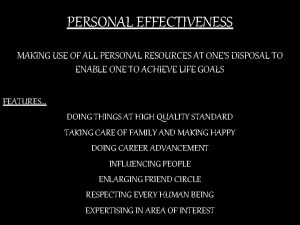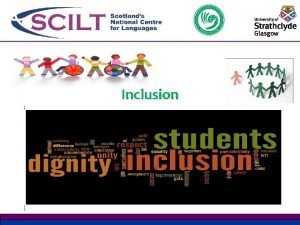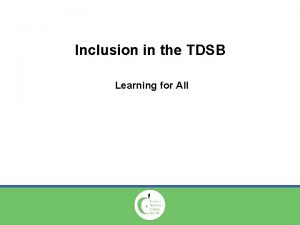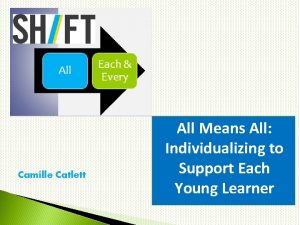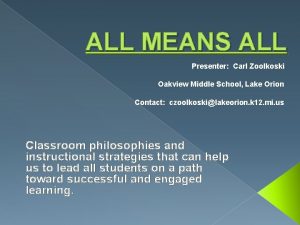Inclusion What is inclusion Inclusion means that all


















- Slides: 18

Inclusion

What is inclusion Inclusion means that all children, regardless of their background or ability, are given the chance to play, learn and interact together. Inclusion is an approach to early childhood learning where every child is valued, supported and given access to equal opportunities and learning experiences. Why is it important? Early learning opportunities and inclusion are crucial to children's development. They give children the social space to learn through play, to connect with other children and to develop a strong sense of who they are. Every child deserves access to these experiences, regardless of their background or ability. In past years, it was the norm for typically developing children and children with additional needs to learn separately. This was largely was due to the fact that most early childhood programs in the community were ill equipped to meet the needs of children who required additional support. Recent research recognises that typically¬ developing children and children with disabilities thrive when they play, learn and interact together rather than separately. Inclusion really benefits everyone — it supports positive childhood development, helps build stronger families and relationships, helps develop quality Early Childhood Education and Care (ECEC) programs and works to create healthy and vibrant communities.

Being inclusive is being mindful of • Race • Gender • Religion • Culture • Ability • National Origin • Socio –Economic Class • Sexual orientation Hint: Child ‘A’ must be able to do what Child ‘B’ can

Characteristics of Inclusive Child Care In an inclusive child care setting: • Children of all physical, emotional, and academic abilities are cared for in the same environment • Children can participate in daily routines and activities with creative adaptations • Children are given the opportunity to grow and develop at their own pace • Children are recognized as individuals with specific strengths and needs • Children have a strong sense of connectedness and belonging Benefits for Children • • In an inclusive child care setting, children develop: A sense of belonging and community Shared experiences with diverse peers A wider variety of friendships Sensitivity and understanding towards others Value for differences in themselves and others Practice being resourceful, creative, and cooperative

Benefits for Families whose children are cared for in an inclusive environment: • Receive high quality child care in a diverse community • Develop an awareness and understanding of people with disabilities • Gain opportunities to teach children about individual differences For educators the benefits of inclusion can be: • opportunities to expand skills, knowledge and professional competence • the opportunity to develop a positive attitude towards inclusion and people with additional needs • increased confidence in working with all children • increased knowledge of other services available in the community • the establishment of contacts and networking with other professionals • the development of an effective teamwork philosophy How can our community support inclusion? Parents, child care providers, community members, nonprofit organizations, businesses, and legislators can: • Share and learn about existing community resources • Identify, request, and coordinate additional provider training and consultation • Advocate for increased funding for inclusion resources

Key Factors To Successful Inclusion The success of the program depends on a range of child, peer, staff, administrative, environmental, family, and community factors. Some key factors that do influence its success include: • a positive attitude towards inclusion must be held by all those involved in the service • a positive attitude towards the child • recognising the importance of working closely with the family of the child with the additional needs • appropriate preparation of the environment and the program • ability to work as a team member Creating an inclusive child care environment Have an anti-bias approach in every aspect of your program. (Anti- bias literally means against bias, free of bias, prejudice and/or preconceived ideas towards people from cultures, socio-economic backgrounds or religious beliefs that differ from your own. This should be extended to include people with additional needs and a non sexist agenda.

According to Tarrant and Jones (1996) staff members need to be aware of the backgrounds and particular needs of the children/families attending the service develop a program that reflects the cultural and social needs of all the children/families in attendance draw on the skills, talents, knowledge and expertise of people from other cultures. Diversity should be shared and appreciated be aware that it is not enough to offer the occasional "multicultural" afternoon tea, for example, and assume the anti-bias aspect of the program has been addressed. This approach is often described as the "tourist approach" as it only happens once in a while, with only a brief glimpse of different cultures. Emphasize the day- to- day living, not just special holidays and customs provide a good role model and actively encourage children to have a positive approach towards minority groups. Watch for biased or stereotyped comments or teasing. Correct children when this situation occurs and explain how hurtful this behaviour can be, involve males and females equally in both "housekeeping" tasks, such as cleaning, and in any games or activities being provided be aware of the possible need for modifications to the environment to enable physical access printed materials or posters in community languages families can be asked for assistance with translations. Try to find pictures, books, music and other items representative of the children's cultures. Reflect an anti-bias approach in every aspect of the program every day of operation.

Be aware of attitudes. In order to create an inclusive environment child care workers must first examine their own attitudes, recognise their own prejudices and learn to deal with them in a positive way. The challenge is for all child care workers to empower themselves and others to confront discrimination issues. Child care workers may benefit from attending training on an anti-bias approach in childcare. Try building up, and making available, a collection of written resources - books or articles - on inclusion for staff, parents and children. Use team meetings to discuss incidents that have occurred so that you may share insights into ways to deal with future situations. Communicate your philosophy in newsletters or meetings with parents. Share with parents some of the situations that can arise in the care environment and brainstorm appropriate responses. Describe strategies for building tolerance in children, such as providing opportunities for positive interactions with people who have additional needs or different ethnic /cultural backgrounds, and talking with children when you notice examples of unfairness and prejudices. With children, use teachable moments - be alert for comments that reveal misunderstandings by children about themselves or others - use these teachable moments, don't ignore them. Prejudicial statements need immediate contradiction by the adult present.

Alert children when their remarks might hurt someone else's feelings and remind them that it is not acceptable to say such things. When you sense that remarks are purposely intended to hurt another child, then treat this the same way as you would treat aggression. Develop children's empathy and acknowledge children's positive actions and behaviours. Develop a rapport with parents. Parents are the most significant people in children's lives and the best outcomes for a child are achieved when child care workers have a good working relationship with parents, and when parents and child care workers reinforce each others efforts. Create an atmosphere in which the parents as well as the child feel welcomed. Demonstrate genuine respect, trust and support for parents. Invite them to tell you about themselves and their child/ren. Encourage parent involvement in your service. Let them know that although you know about child development/ group management, you see the parents as having insights about their child which will be invaluable in planning appropriate care.

Prepare your environment and program so that it reflects the community in which it is based. "All children growing up in Australia today need to be given valid images of Australian society as a whole. It could be argued that children in a service where cultural backgrounds are all similar are in the greatest need of raised awareness of the variety of Australian people. Similarly, in environments where there are few people with disabilities, or few senior citizens, there is a need to expose children to the notion that people come in many shapes, sizes and physical conditions". (Sebastian- Nickell and Milne, 1992). Be part of a team. You are not expected to be experts on cultural practices, positioning, makaton, medical procedures or multiple languages. These are all areas of expertise that other professionals are trained to provide. As a child care worker, your role is to facilitate a team approach to service delivery so children receive a service that is an amalgamation of all the people involved (children, parents, co-workers, group leaders/ directors, therapists, consultants, Support workers).

When people work together they can often accomplish more than individuals can when working independently. Work at developing and maintaining positive working relationships with other staff, your management committee and parents. In child care services, where there are few staff, it can be especially beneficial for staff to build networks with other child care services and other community professionals in related fields. Being prepared in this way can go a long way towards reducing your concerns about your ability to meet the needs of children placed in your care. Inclusion of children with additional needs As you would with any child, bring together information from the parents and your observations of the child. Consider the goals for the child that have been determined through your interview with the parents. Get to know the child. Find out what their likes and dislikes are and where their strengths lie.

Assess your program and child care environment in terms of it's suitability to meet the child's needs. Programs should provide developmentally suitably activities and experiences for all the children in care. Consider the size of your group, the mix of ages, safety issues, use of resources and space, noises levels and timetabling. Be prepared to make changes or modifications as necessary. Check out what resources your service already has, what you might need and how any additional resources may be obtained. Let the child get used to the program gradually. Introduce the child to the other children. Allow the child to participate at their own level in the activities planned. Respect a child's decision not to participate at times. All children should be free to choose organised activities or initiate their own play. If meeting the individual needs of a child is outside your area of prior learning then embrace the challenge-one step at a time. Firstly remember for all the unique, additional needs that individual children might have, all children have the same basic needs. And as carers you are experienced at meeting those basic needs.

Next you need to identify your concerns. For example "I don't know how to communicate with a child who doesn't speak English", "I don't know how to pick up or carry a child with low muscle tone!", "I don't know what to say to a child who has experienced the death of a parent". Now you can move into problem solving. Work with your co-workers, group leader/director/or management committee. You need the support of these people when challenges arise. You may need time, training, resources and encouragement. They may be able to provide more information and recommend helpful resources. Keep them apprised of developments. Let them know what actions you would like to pursue. Seek out information. (Make sure the sources are reliable). General information on a topic provides a good starting point for learning and knowing the more specific questions that you may need to ask parents and others. If appropriate, talk to other professionals. Find out what support they can offer or suggestions they have. Keep records of your actions to support each child and your observations of each child. Records make it possible to look back and see the real progress that you and the child have made, thus they can be a source of encouragement. Communicate with the other members of your team, including the parents. Give feedback stated in positive terms. Ask questions. Listen. Speak about your needs. Acknowledge and celebrate your successes.

Inclusion is supported through legal, moral, rational and empirical factors. Legal Factors. The Commonwealth and State Governments have enacted various Legislative Acts which support inclusive practices and make discrimination unlawful. Moral Factors. Given the general community's acceptance of the principle of social justice, inclusion is simply the "right" thing to do. Rational Factors. As all children benefit from opportunities to accept, respect and appreciate the diversity of all persons in our society, inclusion is an appropriate policy for child care services. Empirical Factors. Research shows that inclusive environments can benefit children's social, emotional, cognitive, language and physical development. Segregated services have been shown to only provide limited benefit to children's overall development. In addition, there is no evidence to suggest that inclusion is harmful for children.

Rights and Advocacy In defending and advocating for the rights and opportunities of all children, Inclusion Now is guided by the Australian Human Rights Commission (formerly the Australian Human Rights and Equal Opportunity Commission). The Australian Human Rights Commission is an independent statutory organisation that report to the federal Parliament on: § Aboriginal & Torres Strait Islander Social Justice § Age Discrimination § Disability Rights § Human Rights § Race Discrimination § Sex Discrimination The Australian Human Rights Commission leads the implementation of the Disability Discrimination Act 1992. This Act makes disability discrimination unlawful and aims to promote equal rights, opportunity and access for people with disabilities.

The Commission also has major responsibilities under the international Convention on the Rights of Persons with Disabilities. The Convention on the Rights of Persons with Disabilities states that people with disabilities have the right to access the same opportunities as all citizens with full and effective inclusion in society. The Convention for the Rights of Children sets out the rights for all children around the world. Two core aspects of this treaty advocate for nondiscrimination and participation of children in the community. All children have the same rights and freedoms regardless of race, background, faith or disability.

Inclusion Roles Inclusion Support Facilitator The Inclusion Support Facilitator (ISF) supports children's services to include all children in their programs. ISFs work directly with eligible Early Childhood Education and Care (ECE) services to provide support, information and guidance to assist them to provide quality inclusive environments for all children. This includes children with disabilities and high support needs, children from Culturally and Linguistically Diverse (CALD) backgrounds, Indigenous children and children from refugee or humanitarian intervention backgrounds. The ISF assists ECEC services to adapt their programs, identify policies and practices that support inclusion, work in partnership with families and link with relevant community groups and services. The Inclusion Support Program is funded by the Federal Government.

Inclusive practices Children’s participation in all aspects of early years programs encourages their development of tolerance, compassion and understanding. Carefully planned environments engage and enable children to co-construct learning and build deep understanding Inclusive settings and practices, through their physical and social systems, can enhance children’s social interactions as well as physical and cognitive development. Research into outstanding inclusive early years classrooms has identified three main opportunities that enhance opportunity to learn (Katz & Galbraith, 2006, p. 14): • Open-ended activities provide opportunity for peers to interact and teach other. • Transitions between routines can become the impetus for social, physical, emotional and cognitive learning and enhance opportunities to develop skills and knowledge. • Staff working collaboratively to plan and provide situations for open- ended and transition activities is vital. Only inclusion has the potential to reduce fear and to build friendship, respect and understanding. Centre for Studies on Inclusive Education (n. d. )
 Phân độ lown ngoại tâm thu
Phân độ lown ngoại tâm thu Block xoang nhĩ độ 2 type 1
Block xoang nhĩ độ 2 type 1 Thơ thất ngôn tứ tuyệt đường luật
Thơ thất ngôn tứ tuyệt đường luật Thơ thất ngôn tứ tuyệt đường luật
Thơ thất ngôn tứ tuyệt đường luật Walmart thất bại ở nhật
Walmart thất bại ở nhật Tìm độ lớn thật của tam giác abc
Tìm độ lớn thật của tam giác abc Con hãy đưa tay khi thấy người vấp ngã
Con hãy đưa tay khi thấy người vấp ngã Tôn thất thuyết là ai
Tôn thất thuyết là ai Gây tê cơ vuông thắt lưng
Gây tê cơ vuông thắt lưng Sau thất bại ở hồ điển triệt
Sau thất bại ở hồ điển triệt Name all the rays
Name all the rays Triangle quadrilateral pentagon hexagon octagon
Triangle quadrilateral pentagon hexagon octagon Morphe means in metamorphism
Morphe means in metamorphism Meta and morph means
Meta and morph means Bio means life diversity means
Bio means life diversity means Bio means life
Bio means life What are the uses of personal resources
What are the uses of personal resources Personal effectiveness meaning
Personal effectiveness meaning Typing in all capitals in electronic communication means
Typing in all capitals in electronic communication means
















